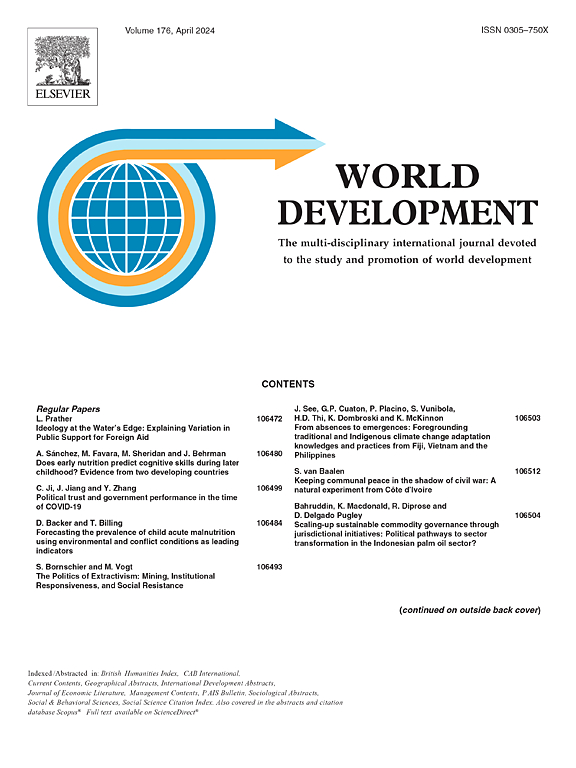Financial inclusion along the Rural-Urban Continuum: Empirical evidence from a decomposition analysis in Kenya between 2012 and 2021
IF 4.8
1区 经济学
Q1 DEVELOPMENT STUDIES
引用次数: 0
Abstract
People in extremely rural areas may face substantially higher levels of financial exclusion than rural averages suggest. Formulating efficient policy measures hence requires a more nuanced understanding of spatial differences in financial inclusion beyond mere averages of rural–urban differences. This study is the first to investigate inequality of financial inclusion along a rural–urban continuum. Using two nationally representative surveys from Kenya collected in 2012 and 2021, we first quantify the overall levels of spatial inequality for both conventional and digital financial inclusion. To do so, we calculate concentration indices (CIs) and make pairwise comparisons between the most rural and most urban areas. We then investigate the spatial inequality across 12 variables, which were previously identified to be important determinants of financial inclusion. Lastly, we estimate which variables are the most important contributors to spatial inequality. We find that both conventional and digital financial inclusion are statistically significantly concentrated among more urban areas compared to more rural areas. These inequality estimates are similar for both types of financial inclusion and persistent over time. Average rural–urban differences are substantially lower than differences between the most urban and most rural quintile of the continuum. Important determinants of both financial inclusion types, such as education, wealth, mobile phone ownership, and trust exhibit persistent and high levels of spatial inequality. Congruently, we find that to decrease spatial inequality in financial inclusion, policy makers should prioritize decreasing spatial inequality of all four aforementioned variables. Researchers should consider the degree of rurality on a continuum rather than a binary rural–urban definition. Results are robust against different econometric strategies, different measurements of inequality, and different specifications of both financial inclusion and the rural–urban continuum.
农村-城市连续体的金融包容性:来自2012年至2021年肯尼亚分解分析的经验证据
极端农村地区的人们可能面临比农村平均水平高得多的金融排斥。因此,制定有效的政策措施需要更细致地了解普惠金融的空间差异,而不仅仅是城乡差异的平均值。本研究首次探讨了农村-城市连续体中金融包容性的不平等。利用2012年和2021年在肯尼亚收集的两项具有全国代表性的调查,我们首先量化了传统金融包容性和数字金融包容性的总体空间不平等水平。为此,我们计算了浓度指数(CIs),并对大多数农村地区和大多数城市地区进行了两两比较。然后,我们研究了12个变量之间的空间不平等,这些变量之前被认为是金融包容性的重要决定因素。最后,我们估计了哪些变量是造成空间不平等的最重要因素。我们发现,传统普惠金融和数字普惠金融在城市地区的集中度显著高于农村地区。对于两种类型的普惠金融,这些不平等估计是相似的,并且随着时间的推移而持续存在。城乡之间的平均差异大大低于连续统一体中最城市和最农村的五分之一之间的差异。两种普惠金融类型的重要决定因素,如教育、财富、手机拥有量和信任,都表现出持续且高度的空间不平等。同时,我们发现要减少普惠金融的空间不平等,政策制定者应该优先减少上述四个变量的空间不平等。研究人员应该考虑一个连续统一体的乡村程度,而不是二元的农村-城市定义。对于不同的计量经济策略、不同的不平等测量方法以及金融普惠和城乡连续体的不同规格,结果都是稳健的。
本文章由计算机程序翻译,如有差异,请以英文原文为准。
求助全文
约1分钟内获得全文
求助全文
来源期刊

World Development
Multiple-
CiteScore
12.70
自引率
5.80%
发文量
320
期刊介绍:
World Development is a multi-disciplinary monthly journal of development studies. It seeks to explore ways of improving standards of living, and the human condition generally, by examining potential solutions to problems such as: poverty, unemployment, malnutrition, disease, lack of shelter, environmental degradation, inadequate scientific and technological resources, trade and payments imbalances, international debt, gender and ethnic discrimination, militarism and civil conflict, and lack of popular participation in economic and political life. Contributions offer constructive ideas and analysis, and highlight the lessons to be learned from the experiences of different nations, societies, and economies.
 求助内容:
求助内容: 应助结果提醒方式:
应助结果提醒方式:


